21 November, 1998
Saturday, November 21st, 1998
Hi! The Cape Roberts camp "saga" continues…woke up at 7:00 AM with Matt
knocking on the outside of our "freezer" to wake us up. He was the only one of
our group with an alarm clock. It seemed way too early to get up…but once I
got out of my warm and toasty sleeping bag…I was moving pretty quickly. When
I stepped outside to go to the outhouse before breakfast….the cold air and
wind hit me like a ton of bricks. Yikes! That outhouse seat was cold and
cold air was circulating in from the cracks between the house and the hole in
the ice. I kept thinking about the outhouse at "Happy Camper" school that had
"Room With A View" written inside of it. As I looked out the back window of
this outhouse…I could see Cape Roberts and the ice and snow around me. I
guess it was a room with a view! One thing I'd like to mention is that they
have a flag system here at this camp that I haven't seen yet. If the flag is
down, then the bathroom is occupied. This prevents you from walking all the
way over to the outhouse and discovering that it's in use. This way, you look
first, then make a run for it, if the flag is up. Clever!
Breakfast was a fresh apple and toast…freshly baked bread, too. Not long
after I arrived in the Jamesway, I heard the HELO coming in for the first
pick-up of the day…the shift change again. Workers on the first shift were
waiting outside, to be shuttled to the drill site. We were listed as round
#4, so we knew we still had plenty of time. Remember, they have to go back
and forth several times, to get everyone to and from the drill site each time
they change shifts. Our HELO finally arrived about 8:45 AM. It was a much
smaller one than last night…called a "squirrel". I sat in the back with
Sandra, and Jaap, and Matt sat up front with the pilot. This ride was so
smooth…unbelievable! It took less than ten minutes to fly to the drill site.
Our pilot circled around the drill site so we could get some good photographs.
We landed softly and within minutes we were in the mess container…being
greeted by Alex Pyne. Alex is the Project Manager at the drill site, a master
engineer and a "jack of all trades." He quickly gave us a run-down of what
we'd be seeing at the drill site, and next he took us outside to identify the
various buildings on site. Alex showed us the bottom part of the drill, which
was behind a kind of heavy tarp to keep the mud from splashing all around. He
took us inside the video hut, where lots of equipment is used to run cameras
below the surface of the ice. This was awesome! We saw the bottom of the sea
floor and the place where the drill goes into the floor of the ocean. Alex
moved the camera around and we got to see the huge air bags used to help give
support to the ice which holds the heavy sea riser and drill rig. We even saw
sponges on the sea floor and a huge jellyfish floating by!
Alex showed us a diagram of how the drill rig is set up and what's underneath
it. I asked him if he could make a sketch for me to use in class. Not only
did he draw a diagram… it's a work of art! I'm going to use it to make an
overhead transparency that I can share with all of you when I get home! It
really shows how the whole thing works…I wish I could scan it in and share it
NOW!
The drill hole was nearing the 500 meter mark today…quite an accomplishment.
This has been a good drilling season. We met Pat Cooper, Chief of Drilling,
and some of the men working on the drill rig. Alex showed us where they mix
the "mud" that goes down the drill hole. Remember when I talked about that in
an earlier journal entry. Look back at Monday, November 9th for the
information.
While we were in the building below (and to the side) of the drill rig, a new
core was brought to the surface. They slid the metal drilling pipe down a
wooden ramp, into the room where we were standing. It was quickly moved to
another wooden shelf. Todd, one of the workers, immediately started using
two huge wrenches to open the ends of the pipe by moving the wrenches in
opposite directions. When this was accomplished, he slid a kind of thin
silver liner out of the pipe. This is what the core was in. Thank goodness I
have pictures to show you…this is hard to explain. After the core was removed
the pipe was flushed out with water. The silver liner was split in half (like
the core is split for us when it comes to Crary Lab). The top of the liner
was carefully opened up and Pat Cooper (along with several other people) took
a preliminary look at the core.
Before we knew it, the core was carefully carried out of this building…and
taken to the core lab building close by. A small trap door was opened and the
core was slid inside. We headed over to the lab to see the next steps in this
process. The core was sprayed off with a fine mist of water that would remove
any "mud" left behind. Eventually the core was cut into smaller segments,
scanned and photographed, looked at my many people in the lab, and finally
sliced in half (like you would slice an orange). I am sure I'm leaving
something out…it was hard to follow all the steps and I wish I had my journal
with me. Once they are done with the core at the drill site…it is flown back
to the lab at Cape Roberts camp where it is described by the sedimentologists.
Then…it's off to Crary Lab.
Later we stopped for a snack in the mess building, and a few of us at a time
could go up to the drilling platform. I jumped at this chance right off.
Forgot to tell you that we had to wear hard hats whenever we were near the
drill rig and the buildings adjacent to it. This is considered an industrial
area and that's a regulation. Up on the drilling platform, I took a ton of
photographs and watched carefully as they worked at lowering the pipe in and
later hauling it out again. I couldn't begin to give this operation a fair
description…it was amazing how everything worked. So many machines, all
working at the same time…so many things to keep track of. It was incredible.
I was lucky enough to be hanging around when they brought up another section
of core. I moved back downstairs to get out of the way of the swinging pipe
and saw the whole process all over again. I got to talking with two
guys…Chris and Todd who helped explain some of the process to me. They were
also interested in the Glacier/TEA web site, so they could put others in touch
with this project. It was so great to meet some of the people who are working
hard to get the core to us back at Crary Lab. It's a complicated process and
takes a lot of cooperation in order for it to be successful. Thanks to Alex
for the great tour and information, and thanks for including me on a trip out
to the site! It was SUPER!
Three Skidoos arrived around noon, to take us back to the Cape Roberts camp.
The four of us from McMurdo were loaded into two of the wagons that are pulled
behind the snowmobiles (on ski runners). We had pads to lean against, but
Sandra and I only had one pad instead of two, so we sat on the cold wooden
floor of the wagon…which got a lot colder as the ride went on. Due to a crack
in the sea ice, the Skidoos have to take a less direct route back to the
camp…26 kilometers! It was a wild and bumpy ride. I felt like my body had
been jiggled to death by the time we arrived at the camp. It was a beautiful
day and I enjoyed (most of the time) the ride. Thanks to Mark, our driver for
getting us back there safely.
I was starving, so the first thing I thought of was lunch. It was already
past 1:00 PM by now, and we had eaten pretty early this morning. Lots of good
food to choose from and I'm beginning to think that the remote camps get a lot
more fresh vegetables and fruit than we get in McMurdo.
Our small group of four had decided to make the most of our afternoon at the
camp and hike over to the icebergs nearby and also to see the seals, which had
come through the large crack in the sea ice. The hike was longer than I
thought it would be…remember, things look closer than they really are. It was
often difficult to walk on the sea ice or through drifts of soft snow that
covered the ice. The hardened drifts were great to walk on, but you never
knew when the hard snow would suddenly turn to soft drifts. The icebergs were
massive and the seals quite numerous. We couldn't climb the iceberg that had
steps carved in it, because of a new crack in the sea ice. We had to be very
careful to look for signs of disturbance in the ice. Not long from now…say
January or February, the ice will be broken up and this area will look so
different than it does now. I wish I could be around for that. It would
really look neat to see chunks of ice floating in the sea!
We watched the seals from a distance, took many photographs, and finally all
sat down on the ice to observe the behavior of one parcticular seal. It was
such a warm and sunny afternoon, that I laid down for a few minutes and dozed
off. The seal started making the funniest sounds…a lot like a helicopter
coming in for a landing and then a little yip at the end of that. We listened
for awhile and finally decided to hike back to the Cape Roberts camp. Back at
camp I caught up on recording some facts in my written journal and took a few
last pictures of the camp. We had our dinner early, so that we would be ready
to board the helicopter after the last people were brought back from the shift
change.
I'd say we took off close to 9:00 PM and we had a short 20 minute ride to
Marble Point. This time the pilot shut down the HELO at Marble Point and we
had time to take a quick 20 minute hike. Back in the HELO, it was another 40
minutes or so to McMurdo…and we were on the ground there by 10:40 PM. A LONG
DAY! The walk up the hill from the helicopter hangar was terrible…wearing
those bunny boots, the ECW gear, and carrying a 30 pound orange duffle bag.
After a shower and a bit of unpacking, I went out to meet some friends and
share my adventure. Hope you enjoyed hearing about today as much as I enjoyed
sharing it. Talk with you tomorrow.
Betty :)
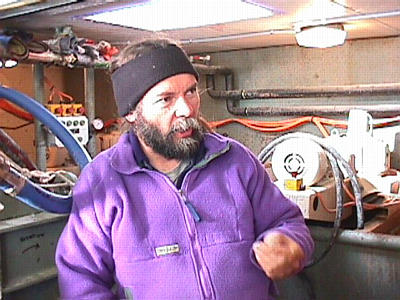
This is Alex Pyne, who gave us a GREAT tour of the drill site. Thanks to Alex and his diagram, I have a much better idea of how things work out there. It really h elps to see the process from start to finish....from the drill rig to Crary Lab.
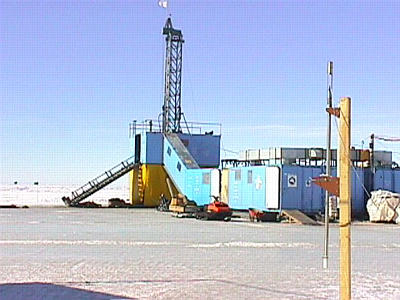
The 1998 Cape Roberts drill site. Notice the building attached to where the drill rig is located. This is where they slide the core down the ramp and remove it fr om the drilling pipe.
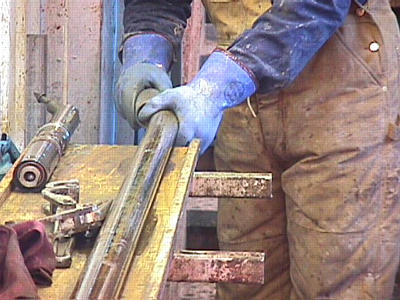
This should give you a better idea of what the core looks like as it is first taken out of the pipe.
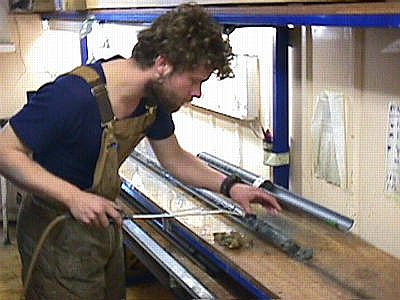
The core is carefully being cleaned up and readied for the next step in the process.

This was one of many machines used to do a "first analysis" of the whole core before it was sliced in half. It measures the magnetic susceptibility of the core. T his is a very expensive machine.
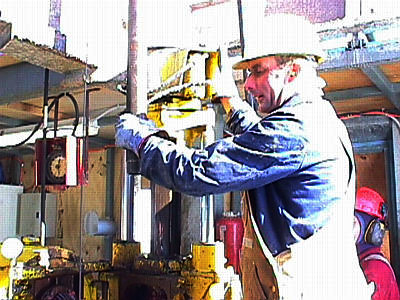
Todd not only worked up on the drilling platform, but down below when the new core came in. He also took it from the drilling area to the trap door in the lab.

This is the bottom part of the drill rig...behind the tarps.
Contact the TEA in the field at
.
If you cannot connect through your browser, copy the
TEA's e-mail address in the "To:" line of
your favorite e-mail package.
|
